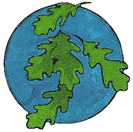

Sources:
Trees of North America- A guide to field identification-a Golden Field Guide from St. Martin's Press © 2002 By C. Frank Brockman p.30
The Encyclopedia of North American Trees by Sam Benvie. Firefly Books Ltd.,2000 Buffalo, NY © 2000 Sam Benvie p.175, 176
Diseases of Trees and Shrubs, 2nd edition, by Wayne A. Sinclair and Howard H. Lyon, © 2005 Cornell University, Cornell University Press, p. 480
USDA, NRCS. 2011. The PLANTS Database (<http://plants.usda.gov/>, 22 August 2011). National Plant Data Team, Greensboro, NC 27401-4901
Plant Fact Sheet, Prepared by and Species Coordinator: USDA NRCS Plant Materials Program
www.efloras.org
Trees of North America- A guide to field identification-a Golden Field Guide from St. Martin's Press © 2002 By C. Frank Brockman p.30
The Encyclopedia of North American Trees by Sam Benvie. Firefly Books Ltd.,2000 Buffalo, NY © 2000 Sam Benvie p.175, 176
Diseases of Trees and Shrubs, 2nd edition, by Wayne A. Sinclair and Howard H. Lyon, © 2005 Cornell University, Cornell University Press, p. 480
USDA, NRCS. 2011. The PLANTS Database (<http://plants.usda.gov/>, 22 August 2011). National Plant Data Team, Greensboro, NC 27401-4901
Plant Fact Sheet, Prepared by and Species Coordinator: USDA NRCS Plant Materials Program
www.efloras.org
Map courtesy USDA NRCS PLANTS Database
Ponderosa Pine,
Pinus ponderosa C. Lawson
Pinus ponderosa C. Lawson
Common names: Bull Pine, Blackjack, Big Heavy Pine, Ponderosa White Pine, Sierra Brown Bark Pine, Silver Pine, Western Pitch Pine, Western Yellow Pine, Western Red Pine, Yellow Pine, Yosemite Pine
State List: AZ, CA, CO, ID, MT, ND, NE, NM, NV, OK, OR, SD, TX, WA, WY
Canada: BC
Visit the Image Gallery for more photos
Visit all North American native pine tree species.
State List: AZ, CA, CO, ID, MT, ND, NE, NM, NV, OK, OR, SD, TX, WA, WY
Canada: BC
Visit the Image Gallery for more photos
Visit all North American native pine tree species.

Ponderosa pine cones, Pinus ponderosa
Photo citation: ©1995 Saint Mary's College of California
Photo citation: ©1995 Saint Mary's College of California
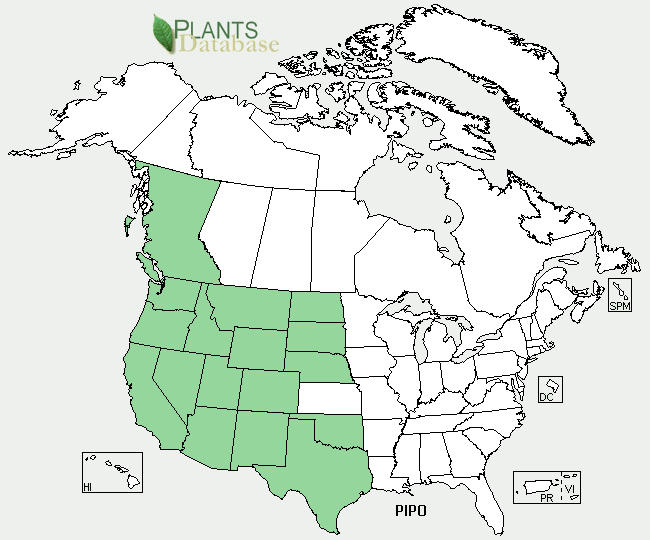
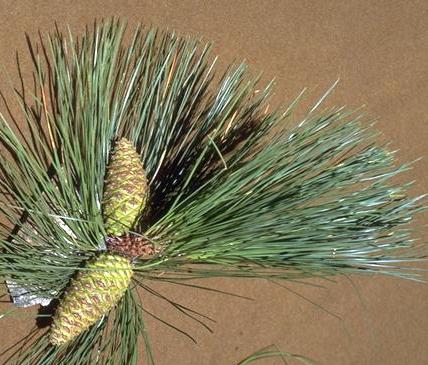
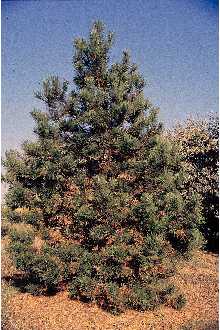
Trunk diameter is typically no larger than 4 feet. Ponderosa pines have a single trunk with rough scaly bark. When young, the bark is dark brown and matures into broad,irregular, reddish-brown to almost orange plates. The crown is broad and open when mature but younger trees have more of a pyramidal structure. Root systems consist of a deep tap root as well as deep laterals 20 inches below
the surface. Needles are in bundles of 2 to 3, are dark yellowish-green, 5 to 10 inches long and form in tufts near branch ends. They are stiff, sharp tipped, and the fascicle persists (stays on tree) after the needle falls, contributing to the rough texture of the twigs. Clustered in threes, Ponderosa pine cones are glossy, reddish-brown, and conical when mature. Immature cones are greenish-yellow brown, are slender and ovoid. The cones grow to 6 inches in length with prickle on each scale. Seeds are brown and single winged.
Habitat
Preferring soils with a pH range of 5.0-9.0, this native conifer is well adapted to a variety of sites. In particular, it is able to grow on essentially bare rock, it's roots seeking out cracks and crevices. It also does well in hot, dry environments with medium textured, deep soils- provided it has ample sunlight as it is shade intolerant. Tolerant of cold winters, it is hardy down to -36°F; however, it needs at least 150 frost free days.
Pinus ponderosa is found at elevations between 6,000 and 8,500 feet. Annual rainfall needs are 15 to 25 inches.
Diseases, Pests, and Elemental Issues
This native pine has quiet a few insect pest and disease
Habitat
Preferring soils with a pH range of 5.0-9.0, this native conifer is well adapted to a variety of sites. In particular, it is able to grow on essentially bare rock, it's roots seeking out cracks and crevices. It also does well in hot, dry environments with medium textured, deep soils- provided it has ample sunlight as it is shade intolerant. Tolerant of cold winters, it is hardy down to -36°F; however, it needs at least 150 frost free days.
Pinus ponderosa is found at elevations between 6,000 and 8,500 feet. Annual rainfall needs are 15 to 25 inches.
Diseases, Pests, and Elemental Issues
This native pine has quiet a few insect pest and disease
shaped swellings. Ponderosa Pine, like Jeffrey Pine, is sensitive to ozone damage. Needles develop chlorotic spots, yellowish-brown in color, irregularly along nearly the entire needle margin. In extremely polluted areas, needles may only be found in two age classes, meaning the needles fall off the trees far sooner than normal. This contributes to the decline of the affected tree by stunting growth and opening a path for secondary agents like insects, fungi and other environmental hazards that inflict further damage. Well documented is the damage to pines in the San Bernadino and San Gabriel Mountains in southern California, caused by photochemical smog blowing in from Los Angeles.
Ethnobotanical and Modern Uses
Ponderosa pine is used in many ways, but is not highly sought after commercially. Most often, it is used as firewood and makes an excellent evergreen windbreak. When planted further apart, wildlife benefit from the ability of the tree to grow a wider crown with higher seed production. The foliage is not often browse food and even when it is, its when no other food source is available. Care should be taken with livestock, as consumption by gestating cows may cause abortions. Commercial uses as a timber tree include posts, utility poles, pulpwood, and a few interior items like cabinets and veneer. It is available in nurseries but should be limited to landscapes with ample room and never beside roads. Like all pines, turpentine can be distilled from the resin. In the early days of turpentine production, Ponderosa pine was one of the primary sources in the west. Explosions would occur unexpectedly and for reasons unknown. It wasn't until Jeffrey Pine was distinguished from Ponderosa Pine that the source of the problem came to light. Ponderosa pine and Jeffrey pine look extremely similar and were harvested together unknowingly as the same tree. Unlike Ponderosa pine resin, Jeffrey pine resin, when distilled, produces almost pure heptane, which is highly volatile and should never be used in turpentine production. Turpentine has been used to treat respiratory ailments like coughs and colds by way of a steam bath or an inhaler, and also put into poultices to treat skin irritations and wounds.
Ethnobotanical and Modern Uses
Ponderosa pine is used in many ways, but is not highly sought after commercially. Most often, it is used as firewood and makes an excellent evergreen windbreak. When planted further apart, wildlife benefit from the ability of the tree to grow a wider crown with higher seed production. The foliage is not often browse food and even when it is, its when no other food source is available. Care should be taken with livestock, as consumption by gestating cows may cause abortions. Commercial uses as a timber tree include posts, utility poles, pulpwood, and a few interior items like cabinets and veneer. It is available in nurseries but should be limited to landscapes with ample room and never beside roads. Like all pines, turpentine can be distilled from the resin. In the early days of turpentine production, Ponderosa pine was one of the primary sources in the west. Explosions would occur unexpectedly and for reasons unknown. It wasn't until Jeffrey Pine was distinguished from Ponderosa Pine that the source of the problem came to light. Ponderosa pine and Jeffrey pine look extremely similar and were harvested together unknowingly as the same tree. Unlike Ponderosa pine resin, Jeffrey pine resin, when distilled, produces almost pure heptane, which is highly volatile and should never be used in turpentine production. Turpentine has been used to treat respiratory ailments like coughs and colds by way of a steam bath or an inhaler, and also put into poultices to treat skin irritations and wounds.
PROTECTED in Nevada
Young Ponderosa Pine
Photo citation: USDA NRCS Database/ Herman D.E. et al. 1996. North Dakota Tree Handbook. USDA NRCS ND State Soil Conservation Committee; NDSU Extension and Western Area Power Authority, Bismark
Photo citation: USDA NRCS Database/ Herman D.E. et al. 1996. North Dakota Tree Handbook. USDA NRCS ND State Soil Conservation Committee; NDSU Extension and Western Area Power Authority, Bismark




™
- Trees
- A-Z scientific
- A-Z by Common Name
- Families
- Aceraceae Maple Family
- Anacardiaceae Sumac Family
- Annonaceae Custard Apple Family
- Aquifoliaceae Holly Family
- Arecaceae, Palm Family
- Betulaceae Birch family
- Bignoniaceae Trumpet Creeper Family
- Burseraceae Frankincense Family
- Caprifoliaceae Honeysuckle Family
- Chrysobalanaceae Coco-plum Family
- Cornaceae Dogwood Family
- Cupressaceae Cypress Family
- Cyrillaceae Cyrilla Family
- Ebenaceae Ebony Family
- Ericaceae Heath Family
- Fabaceae Pea Family
- Fagaceae Beech Family
- Hamamelidaceae Witch Hazel Ffamily
- Hippocastanaceae Horse Chestnut Family
- Juglandaceae Walnut Family
- Lauraceae Laurel Family
- Leitneriaceae Corkwood Family
- Magnoliaceae Magnolia Family
- Meliaceae Mahogany Family
- Moraceae Mulberry Family
- Myricaceae Bayberry Family
- Myrsinaceae Myrsine Family
- Myrtaceae Myrtle Family
- Nyctaginaceae Four Oclock Family
- Olacaceae Olax Family
- Oleaceae Olive Family
- Pinaceae Pine Family
- Platanaceae Plane Tree Family
- Polygonaceae Buckwheat Family
- Rhamnaceae Buckthorn Family
- Rosaceae Rose Family
- Rubiaceae Madder Family
- Rutaceae Rue Family
- Salicaceae Willow Family
- Sapindaceae Soapberry Family
- Sapotaceae Sapodilla Family
- Simaroubaceae Quassia Family
- Styracaceae Storax Family
- Symplocaceae Sweetleaf Family
- Theaceae Tea Family
- Tiliaceae Lindon Family
- Ulmaceae Elm Family
- Taxaceae Yew Family
- Yucca Family
- Browse by State
- Rare or Endangered Species
- Trees_with_Special_Uses
- Tallest and Biggest
- Noxious Weeds
- Causes
- About Us
- Our Stores
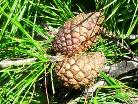
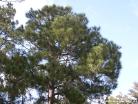
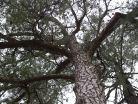
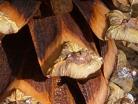
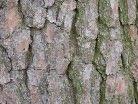
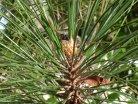
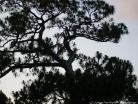

Custom Search


Want to add your tree to our picture gallery? Click here for details!
Tree lists:
•A-Z by scientific
name
•A-Z by common
name
•By Family
For state A-Z list click state name below.
•A-Z by scientific
name
•A-Z by common
name
•By Family
For state A-Z list click state name below.
-Color denotes a tree that is rare or endangered

Botanical
Two varieties exist for Ponderosa Pine:
Pinus ponderosa var. arizonica, native to the southwest
Pinus ponderosa var. scopulorum, found east of the Continental Divide
Ponderosa pines are towering trees, regularly hitting the record books and recently taking the title of tallest pine in the world at a staggering 268.35 feet tall. Height ranges between 150 to 223 feet usually, but greater heights have been recorded at optimum sites.
Two varieties exist for Ponderosa Pine:
Pinus ponderosa var. arizonica, native to the southwest
Pinus ponderosa var. scopulorum, found east of the Continental Divide
Ponderosa pines are towering trees, regularly hitting the record books and recently taking the title of tallest pine in the world at a staggering 268.35 feet tall. Height ranges between 150 to 223 feet usually, but greater heights have been recorded at optimum sites.
susceptibilities. Among them is the Ips bark beetle which attacks young trees. Trees in lower elevations are prone to mistletoe, which is a parasite that can eventually cause mortality. Throughout it's range, Western Gall rust is another negative agent and causes spindle
